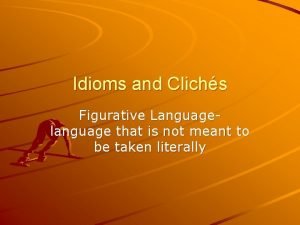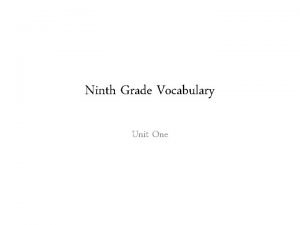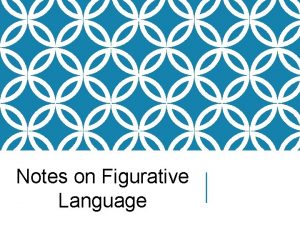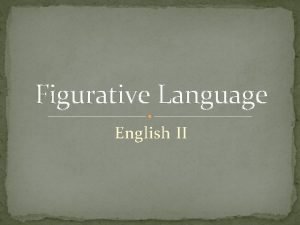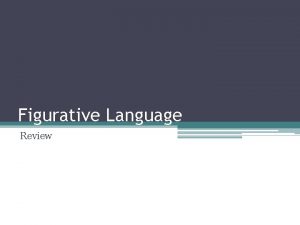NINTH GRADE ENGLISH NOTES Figurative Languagelanguage that is





- Slides: 5

NINTH GRADE ENGLISH NOTES • Figurative Language—language that is not meant to be understood literally; includes the use of simile, metaphor, analogy, personification, hyperbole, oxymoron, idiom, symbolism, irony, paradox, and allusion • Simile—a comparison of two things using the words like or as (or any word or phrase that means like or as) EX: My brother eats like a pig. • Metaphor—a direct comparison of two things without using like or as: uses a linking verb EX: My brother is a pig.

• Analogy—an extended simile or metaphor that shows how two things are similar in two or more ways EX: My brother is a pig! He never cleans his room and he eats everything in the refrigerator. • Personification—a type of figurative language that gives human qualities to something non-human EX: The wind whispered through the trees. • Hyperbole—an exaggeration EX: We had to park a million miles away!

• Idiom—an expression that means something different from the literal definition of the words in the expression. EX: I’m all ears. Let’s call it a day. • Symbolism—the use of an object to represent something else. EX: Dove=peace • Irony—Situational irony involves an outcome in a situation that is opposite of what is expected EX: President Reagan is shot by a bullet that ricocheted off the bullet proof glass of his limo. • Dramatic Irony—occurs when a reader is aware of a situation that the character in the

• Verbal Irony—the use of language that is opposite of what is actually meant. EX: When a brother says to his little sister, “Boy, you’re a genius!” • Paradox—a situation or a statement that contains seemingly contradictory ideas. EX: When the sun sets it also rises. Q: How does paradox differ from oxymoron? A: An oxymoron tends to be one or two words while a paradox is a statement or a situation. • Allusion—an indirect reference to a person, a piece of literature, a historical event, or another familiar thing…. Mrs. New’s definition:

To whom is Kanye alluding in this line? “Bow in the presence of greatness / ‘Cause right now thou hast forsaken us / You should be honored by my lateness. ” • Imagery—words that appeal to the readers’ senses. EX: The tinkling brook sent its cool waters along the green shoreline. {Sound image, Feeling image, and Sight image}
